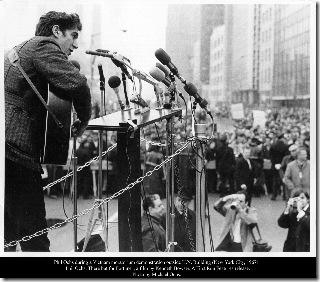Phil Ochs was a protest singer’s protest singer. He wrote what he saw, and what he saw was injustice. Unlike more famous and more lauded protest singers, he didn’t couch his songs in metaphor – he was incisive and disturbing.
On American Masters [PBS, 10/9C], Phil Ochs: There But For Fortune follows Ochs’ life and music from its beginnings in the early sixties to his suicide at 35.
For me, it’s really hard to watch Phil Ochs: There But For Fortune. From the mid-sixties, he was my personal favorite of all the protest singers in that explosion of folk music that made Bob Dylan a legend. In those years, following protest singers was the closest thing we had to a movement of any kind – unlike today, when anyone with a unique point of view, or a particularly keen sense of humor can reach thousands via blogs and Twitter. His suicide affected me on a personal, visceral level – just like his music
Phil Ochs: There But for Fortune not only looks at Ochs, the person and Ochs the singer/songwriter, it also looks at how protest music was a focus for the disenchanted, the victims. From family members – Alice Ochs [wife], Michael Ochs [bother, personal manager] and Meegan Ochs [daughter] – to friends and fellow musicians – Van Dyke Parks [musician], Dave Van Ronk [musician], Joan Baez [friend, musician], Ed Sanders of The Fugs [musician, friend, political activist], Jac Holzman [founder, Elektra Records] and Jerry Moss [co-founder, A&M Records] to name but a few – more than a dozen people who were there talk about their association with Ochs and what that meant to them.
Moving between talking heads and voiceovers [over collages of photos from that era] and interwoven with more than a dozen of Ochs’ songs, Phil Ochs: There But For Fortune is about Ochs’ commitment to what he believed was right – about his awareness of the injustices in America and his refusal to describe them in anything other than plain terms, when others, like Dylan, preferred metaphor more often than not. It’s about a man with both a huge ego and the talent, insight and pure brass to back it up.
It looks, unflinchingly, at his triumphs and disasters and deals with his manic depression, incipient schizophrenia, and alcoholism – and how they all played a part in his life and death. It’s a story that has the drama of a Hamlet; the wit of a Lenny Bruce or George Carlin and the tragedy of a train wreck you can see coming from a distance but are too far away to be able to prevent.
And through it all are those songs: When I’m Gone, Santo Domingo, I Ain’t Marchin’ Anymore, Love me I’m A Liberal, Changes, Small Circle of Friends – songs that, with very few editorial changes [names, places, dates] that are, unhappily, as relevant today as they’ve ever been. In fact, Jello Biafra describes how few changes he had to make to Love Me I’m A Liberal to make it work for the Clinton years – and sings a few lines to show how it applies to the Obama administration.
Written and directed by Kenneth Boswer, Phil Ochs: There But For Fortune mentions Ochs’ personal life briefly, but is mostly concerned with his music and his belief that music could provoke political change as well as cultural – and the role that naiveté might have played in accelerating his mental health issues.
From his days as a have-guitar-will-protest activist [he would turn down a paying gig if he felt a benefit would actually be of benefit], through his ironic experimental period [working with melody and countermelody in unusual orchestral arrangements, or backing a song about injustice with a happy honky tonk piano], to his downright satirical final albums [Phil Ochs’ Greatest Hits’ cover featuring Och’s in an Elvis Presley-inspired gold lame suit, for example], Bowser details Ochs’ growth as an artist in juxtaposition with the growth of his inner demons.
Ochs would never be an overwhelming financial success, his songs not covered by the legions that flocked to cover Dylan, but he was a unique voice who inspired admiration from counterculture figures like Abbie Hoffman, and put his body in the line of fire for causes he believed in – he went to Chicago for the Democratic convention in 1968 and was gassed during the riots that ensued – when other acts backed off.
Phil Ochs had big brass ones and Phil Ochs: There But For Fortune is not only a superb documentary, it is – at the very least – his due.
Final Grade: A+
Photos courtesy PBS


11 minutes had to be cut for the TV version. For more info on his early life as a child and in Greenwich Village, please see the complete movie on DVD or Netflix.